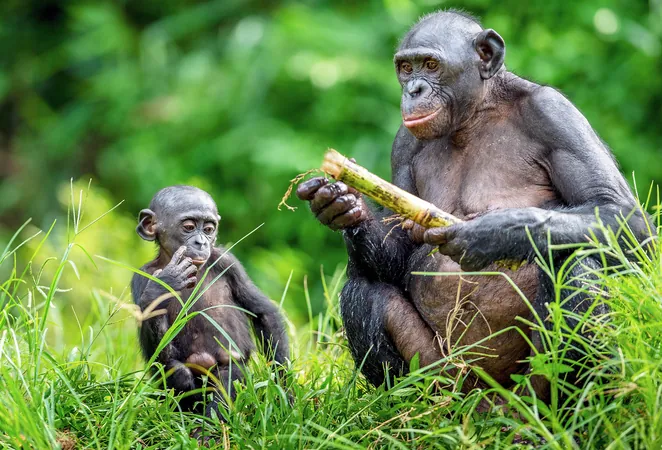
Bonobos Exhibit Language-like Communication Skills That May Reshape Understanding of Animal Intelligence
2025-04-06
Author: Wei
Bonobos, our closest living relatives, have sparked a new conversation in the realm of animal communication. Although they don’t converse with words like humans do, recent findings from a study conducted by researchers at the University of Zurich and Harvard University present compelling evidence that bonobos utilize sophisticated vocal combinations akin to human language.
This groundbreaking research centered on observing wild bonobos in the Kokolopori Community Reserve, located in the Democratic Republic of Congo. The study revealed that bonobos’ vocalizations adhere to principles of compositionality, a defining characteristic of human language. Unlike random sounds, bonobo calls are structured and purposeful, displaying an unexpected level of complexity that challenges prior beliefs about non-human communication capabilities.
A Closer Look at Compositionality
A unique hallmark of human language is compositionality, which allows individuals to combine simple elements into more complex, meaningful expressions. For instance, when describing a dancer, saying "a dancer can be blond" conveys a clear characteristic, while "a dancer can be bad" imparts a judgment about performance. This concept has two forms: trivial compositionality, where meanings remain independent, and nontrivial compositionality, where the combination alters the original meanings.
Historically, research has demonstrated trivial compositionality in certain bird species and primates, but evidence of nontrivial compositionality — the ability to modify and reshape meaning — was elusive. The recent findings regarding bonobos illustrate a shift in this understanding, suggesting that these primates may possess the ability to manipulate meaning through complex call combinations in a manner similar to humans.
Deep Dive into Bonobo Communication
In the study, researchers recorded approximately 700 vocalizations from bonobos, meticulously annotating over 300 contextual features for each sound. This extensive data collection allowed researchers to map out the meanings of different calls based on their context. Using distributional semantics, a linguistic methodology often applied to human languages, scientists were able to analyze how bonobo calls clustered meaningfully based on their similar contexts.
The rigorous analytical process involved evaluating each call type, determining if their combinations had distinct meanings, and identifying instances where the whole exceeded the sum of its parts, thus indicating nontrivial compositionality. Astonishingly, the findings revealed that out of seven call types analyzed, three demonstrated nontrivial structures. This is monumental, as it indicates that bonobos not only combine calls in meaningful ways but do so reflecting the intricate structures of human language.
Understanding the Meaning Behind Bonobo Calls
Understanding bonobo communication requires more than recognizing call types; it involves interpreting the underlying purpose of each sound. For example, grunts may signal "look at me," while high-hoots serve as attention-getters during tense moments. Low-hoots indicate excitement, and whistles facilitate group cohesion, suggesting nuances of social interaction.
Notably, combinations of calls can imply complex meanings. For instance, the combination of "Peep_Whistle" could express a desire for group unity during sensitive moments, while "High-hoot_Low-hoot" may indicate urgency or distress.
Implications of the Findings
These findings not only provide insight into bonobo communication but also potentially illuminate the evolutionary origins of human language. With humans and bonobos sharing a common ancestor approximately 7 to 13 million years ago, the study suggests that the capacity for compositionality may have been present in our shared lineage much earlier than previously thought. The results imply that the evolution of language was not a sudden advancement but rather a gradual development rooted in our ancestral past.
The methodology employed in the study could serve as a blueprint for investigating communication in other animal species, from dolphins to elephants. By focusing on context and minimizing subjective interpretations, researchers can uncover the intricacies of animal communication across species.
The Ongoing Journey of Discovery
While bonobos display remarkable communication abilities, it's important to acknowledge that their vocalizations may convey more than mere intentions; they could also express emotional states. Furthermore, bonobos often combine vocal calls with gestures and facial expressions, suggesting a complex, multimodal communication system that may unveil even more sophisticated layers of social interactions.
The compelling evidence presented in this research reveals that bonobos do not simply produce sounds; they engage in structured, meaningful communication. As we continue to explore the depths of animal language, it becomes clear that the origins of language may be deeper and more intertwined with our evolutionary story than anyone previously imagined.
This study, published in the journal *Science*, certainly provides a compelling glimpse into the world of bonobo communication, prompting us to rethink the boundaries of language and intelligence in the animal kingdom. Are we on the brink of redefining what it means to understand language? Stay tuned, as the journey of discovery continues.



 Brasil (PT)
Brasil (PT)
 Canada (EN)
Canada (EN)
 Chile (ES)
Chile (ES)
 Česko (CS)
Česko (CS)
 대한민국 (KO)
대한민국 (KO)
 España (ES)
España (ES)
 France (FR)
France (FR)
 Hong Kong (EN)
Hong Kong (EN)
 Italia (IT)
Italia (IT)
 日本 (JA)
日本 (JA)
 Magyarország (HU)
Magyarország (HU)
 Norge (NO)
Norge (NO)
 Polska (PL)
Polska (PL)
 Schweiz (DE)
Schweiz (DE)
 Singapore (EN)
Singapore (EN)
 Sverige (SV)
Sverige (SV)
 Suomi (FI)
Suomi (FI)
 Türkiye (TR)
Türkiye (TR)
 الإمارات العربية المتحدة (AR)
الإمارات العربية المتحدة (AR)